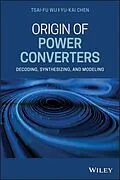A comprehensive guide to approaches to decoding, synthesizing and modeling pulse width modulation (PWM) converters
Origin of Power Converters explores the original converter and provides a systematic examination of the development and modeling of power converters based on decoding and synthesizing approaches. The authors--noted experts on the topic--present an introduction to the origins of the converter and detail the fundamentals related to power the converter's evolution. They cover a range of converter synthesis approaches, synthesis of multi-stage/multi-level converters, extension of hard-switching converters to soft-switching ones, and determination of switch-voltage stresses in the converters.
In later chapters, this comprehensive resource reviews conventional two-port network theory and the state-space averaged (SSA) modeling approach, from which systematic modeling approaches are based on the graft switch technique. In addition, the book reviews the converter layer scheme and some fundamental circuit theories. This important book:
* Contains a review of several typical transfer codes, such as step-down, step-up, step-up&-down, and ± step-up&-down
* Describes the syntheses of pulse width modulation (PWM) converters such as voltage-fed z-source, current-fed z-source, quasi z-source, switched capacitor, and switched inductor converters
* Presents two application examples based on previously proposed modeling approaches
Written for academic researchers, graduate students, and seniors in power electronics, Origin of Power Converters provides a comprehensive understanding of the evolution of the converter and its applications.
Autorentext
TSAI-FU WU, PHD, is a Distinguished Professor in the Department of Electrical Engineering, National Tsing Hua University, Hsinchu, Taiwan. Dr. Wu has been an Associate Editor for the IEEE Transactions on Power Electronics since 2000.
YU-KAI CHEN, PHD, is a Professor in the Innovative Design and Energy Application Laboratory at National Formosa University, Yunlin, Taiwan.
Klappentext
A comprehensive guide to approaches to decoding, synthesizing, and modeling pulse width modulation (PWM) converters
Origin of Power Converters??explores the original converter and provides a systematic examination of the development and modeling of power converters based on decoding and synthesizing approaches. The authorsnoted experts on the topicpresent an introduction to the origins of the converter and detail the fundamentals related to power the converter's evolution. They cover a range of converter synthesis approaches, synthesis of multi-stage/multi-level converters, extension of hard-switching converters to soft-switching ones, and determination of switch-voltage stresses in the converters.
In later chapters, this comprehensive resource reviews conventional two-port network theory and the state-space averaged (SSA) modeling approach, from which systematic modeling approaches are based on the graft switch technique. In addition, the book reviews the converter layer scheme and some fundamental circuit theories. This important book:
- Contains a review of several typical transfer codes, such as step-down, step-up, step-up&-down, and ± step-up&-down
- Describes the syntheses of pulse width modulation (PWM) converters such as voltage-fed z-source, current-fed z-source, quasi z-source, switched capacitor, and switched inductor converters
- Presents two application examples based on previously proposed modeling approaches
Written for academic researchers, graduate students, and seniors in power electronics,??Origin of Power Converters??provides a comprehensive understanding of the evolution of the converter and its applications.
Inhalt
Preface xv
Acknowledgments xvii
About the Authors xviii
Part I Decoding and Synthesizing 1
1 Introduction 3
1.1 Power Processing Systems 4
1.2 Non-PWM Converters Versus PWM Converters 7
1.2.1 Non-PWM Converters 7
1.2.2 PWM Power Converters 9
1.3 Well-Known PWM Converters 10
1.4 Approaches to Converter Development 17
1.5 Evolution 25
1.6 About the Text 26
1.6.1 Part I: Decoding and Synthesizing 26
1.6.2 Part II: Modeling and Applications 28
Further Reading 28
2 Discovery of Original Converter 31
2.1 Creation of Original Converter 31
2.1.1 SourceLoad Approach 32
2.1.2 ProtonNeutronMeson Analogy 32
2.1.3 Resonance Approach 33
2.2 Fundamental PWM Converters 34
2.2.1 Voltage Transfer Ratios 35
2.2.2 CCM Operation 36
2.2.3 DCM Operation 38
2.2.4 Inverse Operation 39
2.3 Duality 40
Further Reading 41
3 Fundamentals 43
3.1 DC Voltage and Current Offsetting 43
3.1.1 DC Voltage Offsetting 44
3.1.2 DC Current Offsetting 47
3.2 Capacitor and Inductor Splitting 49
3.3 DC-Voltage Blocking and Pulsating-Voltage Filtering 51
3.4 Magnetic Coupling 55
3.5 DC Transformer 58
3.6 Switch Grafting 62
3.7 Diode Grafting 67
3.8 Layer Scheme 72
Further Reading 74
4 Decoding Process 77
4.1 Transfer Ratios (Codes) 77
4.2 Transfer Code Configurations 82
4.2.1 Cascade Configuration 82
4.2.2 Feedback Configuration 82
4.2.3 Feedforward Configuration 83
4.2.4 Parallel Configuration 85
4.3 Decoding Approaches 86
4.3.1 Factorization 86
4.3.2 Long Division 88
4.3.3 Cross Multiplication 89
4.4 Decoding of Transfer Codes with Multivariables 91
4.5 Decoding with Component-Interconnected Expression 93
Further Reading 94
5 Synthesizing Process with Graft Scheme 95
5.1 Cell Approaches 95
5.1.1 P-Cell and N-Cell 96
5.1.2 Tee Canonical Cell and Pi Canonical Cell 97
5.1.3 Switched-Capacitor Cell and Switched-Inductor Cell 98
5.1.4 InductorCapacitor Component Cells 100
5.2 Converter Grafting Scheme 101
5.2.1 Synchronous Switch Operation 101
5.2.2 Grafting Active Switches 103
5.2.3 Grafting Passive Switches 108
5.3 Illustration of Grafting Converters 110
5.3.1 Grafting the Well-Known PWM Converters 110
5.3.1.1 Graft Boost on Buck 111
5.3.1.2 Graft Buck on Boost 112
5.3.1.3 Graft Buck on BuckBoost 114
5.3.1.4 Graft Boost on BoostBuck 116
5.3.1.5 Buck in Parallel with BuckBoost 119
5.3.1.6 Grafting Buck on Buck to Achieve High Step-Down Voltage Conversion 119
5.3.1.7 Grafting Boost on Boost to Achieve High Step-up Voltage Conversion 120
5.3.1.8 Grafting Boost (CCM) on Buck (DCM) 121
5.3.1.9 Cascode Complementary Zeta with Buck 123
5.3.2 Grafting Various Types of Converters 124
5.3.2.1 Grafting Half-Bridge Resonant Inverter on Dither Boost Converter 124
5.3.2.2 Grafting Half-Bridge Resonant Inverter on Bidirectional Flyback Converter 124
5.3.2.3 Grafting Class-E Converter on Boost Converter 125
5.3.3 Integrating Converters with Active and Passive Grafted Switches 127
5.3.3.1 Grafting Buck on Boost with Grafted Diode 128
5.3.3.2 Grafting Half-Bridge Inverter on Interleaved Boost Converters in DCM 128
5.3.3.3 Grafting N-Converters with TGS 130
5.3.3.4 Grafting N-Converters with ΠGS 130
Further Reading 132
6 Synthesizing Process with Layer Scheme 133
6.1 Converter...
